Ridge to Rivers Partnership leads to cooperative management of Boise Foothills
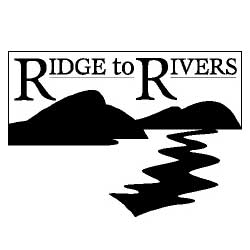
Ridge To Rivers
The Boise Foothills, a large open space area right outside the back door of Idaho’s Capital city, have become a favorite playground for hikers, mountain bikers, runners, dog-walkers and OHV’s.
User groups say the Ridge to Rivers Trail System, which stretches from the top of the foothills to the valley floor, is one of the best trail networks anywhere in the West, with 135 miles of trails.
“We’re phenomenally lucky to have what we have here,” said Marianne Konvalinka, an active dog-walker who provides leadership among dog walkers to pick up after their pets. “I do a lot of traveling for work, and I can tell you, this is unparalleled, especially when it comes to off-leash dog trails.”
Adds Margie Rosenberg, president of the Southwest Idaho Mountain Biking Association (SWIMBA), “Boise gets a lot of national publicity in national magazines for its trail system. I don’t think anyone has as good of backdoor access as we do. We have lovely trails. It’s an awesome trail system.”

Deb Glazer of Boise is part of a regular women’s running group called the Boise B’s that uses the Boise Foothills trail system several times a week.
To keep order among all of the different user groups, a visionary partnership called Ridge to Rivers was formed in 1992. Today, land managers say it’s a model that provides near-seamless management of multiple uses in the foothills. Ridge to Rivers is overseen by five agencies that comprise the partnership — Boise Parks & Recreation, Ada County Open Space & Trails, Bureau of Land Management, Idaho Department of Fish and Game and U.S. Forest Service.
“That partnership is outstanding,” says Stephaney Church, Mountain District Ranger for the Boise National Forest. “If you spend some time on the trails here, you’ll see that you go from the forest, to BLM, to Boise city property, and you’ll find the same signing system throughout.”
The partnership merges the management responsibilities of the different agencies, and it’s not just about recreation. “With Ridge to Rivers, the foothills are managed as a single ownership,” says Larry Ridenhour. “The foothills are sort of Boise’s backyard playground. But for the BLM, we have to manage for range, wildlife, vegetation — a lot of other uses than just recreation.”
The agencies manage more than recreation. Several bands of domestic sheep graze through the foothills in the spring and fall, and the Idaho Department of Fish and Game manages a 36,000-acre winter game range in the east foothills.
“I don’t know of another large wildlife management area close to a major city like this,” says Ed Bottum, manager of the Boise River Wildlife Management Area (WMA). “We have trail-counters installed at our trailheads, and we’ve had about 14,000 user days on the Homestead Trail in each of the last several years. Almost none of them are hunters. That speaks to how valuable the WMA is to the people of Boise.”
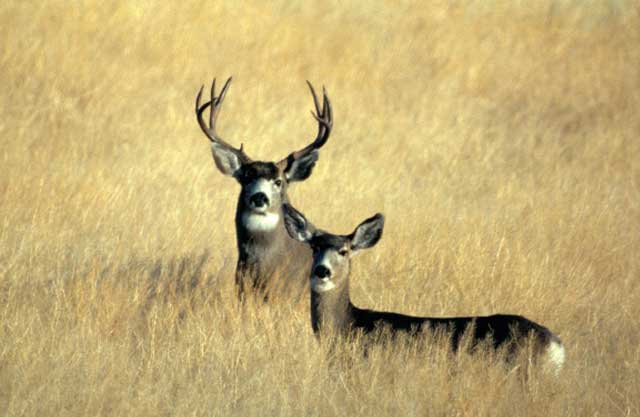
The Boise River Wildlife Management Area is one of the largest winter game ranges close to a major city in the West. It covers 36,000 acres from Black’s Creek to the foothills above Harris Ranch.
Wilder sheep rancher Frank Shirts says it can be a challenge for his herders to move sheep through all of the foothills recreation traffic, but most people like to see the sheep passing through. “Ninety-five percent of them love to see the sheep. They say, “Gall, this is so neat! This is like old times.” But you’ve got to run them right, and everyone has to respect each other. There’s no doubt about that,” Shirts says.
Indeed. Respect for other users and lots of education about the responsible, shared-use of the foothills has been instrumental in maintaining good relations between different user groups. The Ridge to Rivers program has been working on education since its inception.
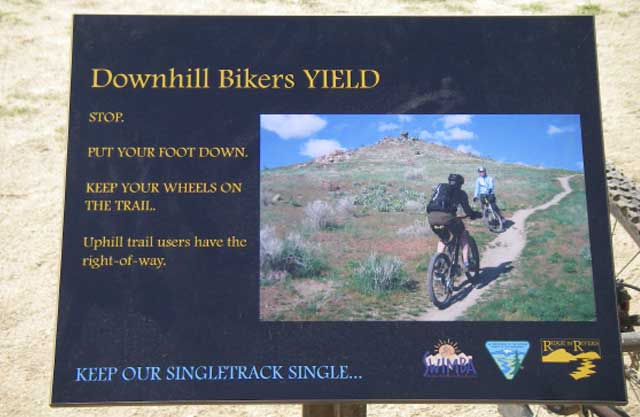
Trailside trail etiquette signs help educate trail users about the importance of ensuring that everyone’s recreational outing is a good one.
David Gordon, Ridge to Rivers Trail Program Coordinator, says the educational efforts have been paying off. “I think we’re seeing better cooperation from the user groups than we did 5-6 years ago,” he says. “Folks are paying better attention to trail etiquette, and that’s a good thing. I think trail users are motivated by the concern that that we need to all work together to share the trails or our uses could get separated — and all users stand to lose if that happens.”
Both Konvalinka and Rosenberg participate in a sub-group called Foothills Advocates for Shared Trails, which includes runners, hikers, mountain bikers and dog-walkers. The group works on educating trail users about trail etiquette, staying off muddy trails in the winter, picking up after pets, keeping singletrack single, and more.
“The busier the trails are, the more we all need to understand that our trail use shouldn’t negatively impact someone else’s use,” says Konvalinka. “We all need to get along.”
Adds Rosenberg, “It’s critical. Mountain bikers go faster than hikers, and it’s important to respect that the other person’s trail experience is just as important as yours. And it’s the way we can keep the trails open to everyone.”
Ridge to Rivers has placed color trail etiquette signs along foothills trails, and it also has produced PSA’s for local TV stations to broadcast and brochures. The Ridge to Rivers web site also provides educational information and a regular trail report to give trail users updates on trail conditions and other information.
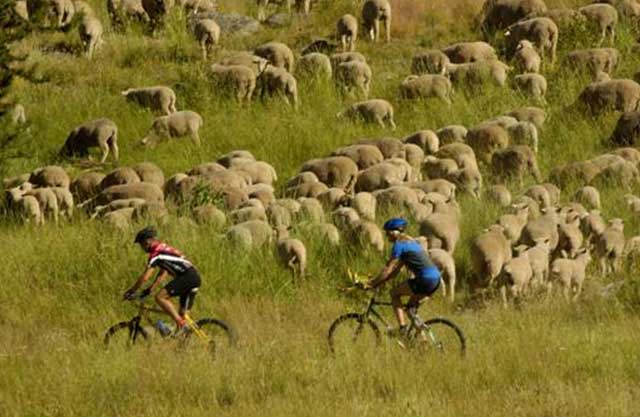
Domestic sheep have been trailed through the Boise Foothills for more than a century. Increased recreation traffic can make it more of a challenge for ranchers, and recreationists have to watch out for guard dogs and keep their pets on a leash. The Care & Share program helps educate recreationists about the issue.
One of the biggest challenges, Gordon says, is convincing hikers and mountain bikers to stay off muddy trails in the winter time. In the lower foothills, the moderate weather in Boise can melt snow and ice during the day, tempting recreationists to use the trails. “It’s a challenge,” Gordon says. “We’re trying to get people to realize that a lot of damage can occur during the winter months. When trails soften up and get muddy, it’s time to stay off the trails.”
To give recreationists a head’s up about sheep moving through the foothills, the Idaho Rangeland Resources Commission does media outreach in the spring. Care & Share signage at trailheads with catchy names like “Wooly Wisdom” remind trail users that they may encounter livestock at certain times of the year. The educational efforts have been effective in educating dog owners about keeping pets leashed and teaching mountain bikers how to deal with guard dogs.
“It’s up to us to educate the public that the foothills are managed for multiple use,” Ridenhour says. “Sheep grazing is a valid use that occurs here. But for someone who may have just moved here, they might be riding a mountain bike on the trails all summer, and then they see a thousand sheep coming through in October, and they’re probably wondering, “hey, what the heck is this about?” “
Shirts says that domestic dogs can make it difficult to keep the sheep grazing in prime recreation areas in the lower foothills for more than a day or two. “I’ve watched people complain after letting their dogs loose among the sheep, and then they wonder why one of our guard dogs comes out to defend the sheep,” he says. “The herder had 3-4 days of feed there, but it’s just too hard to keep the sheep in there for more than a day or two.”
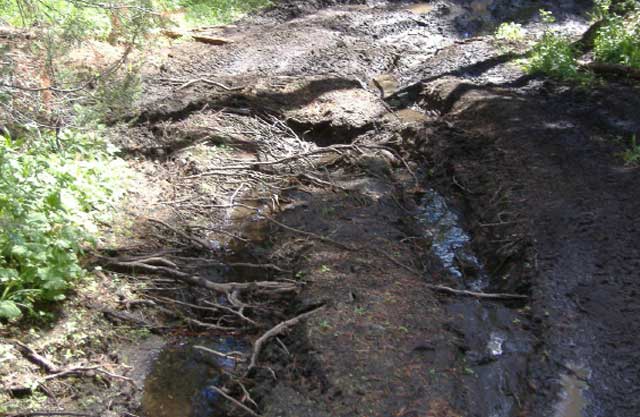
Off-trail riding by ATV’s is an issue on the crest of the Boise Foothills.
At least with advance publicity, recreation users know that the sheep are moving through, and they can use alternative trails or the Greenbelt for a few days, Ridenhour says.
Other issues that agency managers deal with include motorbikes and ATVs pioneering new trails instead of staying on designated trails. “We struggle with a lot of unauthorized ATV and motorized use … lots of hill-climbing that creates a very big erosion problem,” says Church.
The Forest Service and BLM are putting up fences to stop motorized trail users from going off-trail on the north end of 8th Street and on the Boise Ridge Road.
Another issue on the Boise River WMA is people and dogs chasing deer when hunting for antlers. “I personally have seen people letting their dogs chase deer,” said Bottum. “Their theory seems to be that if they chase deer around, their antlers will pop off. That, to me, is about the worst thing we can do on a winter range.”
There also are issues with dog owners failing to pick up dog poop. The city has begun writing tickets to dog owners to boost compliance. “Enforcement is a good thing,” Konvalinka says. “People have to pick up after their pets … no one else is going to pick up their dog poop.”
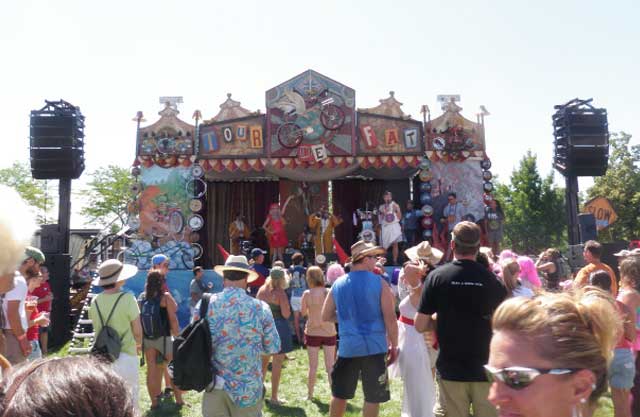
Tour de Fat, sponsored by the New Belgium Brewery, raises a ton of money for SWIMBA, the Boise Bicycle Project and other cycling-oriented causes every year. Proceeds have been spent directly on new trails in the Boise Foothills, like the new Fat Tire Connector Trail.
Most of the time, however, user groups and agencies work on positive projects that enhance the Boise Foothills.
The $10 million Boise Foothills open space levy, passed by a voter majority in 2001, has allowed the city to buy private land in the foothills and the Stack Rock area, opening the way for new trails to be built to spread out use.
With funds from the New Belgium Fat Tire Festival, SWIMBA contributes to new trails and builds them with volunteers. SWIMBA logged more than 1,500 hours of volunteer labor in the last year, Rosenberg says. “We recently completed Mahalo Phase 1, and flagged Phase 2, we’ve done a lot of work on the Bogus Basin trail system, and we funded the Fat Tire Traverse trail. I could go on and on.”

Ed Bottum celebrates the new wildlife underpass on Idaho 21. It should reduce winter road kill mortality for deer and elk. (Photo courtesy Idaho Fish and Game.)
A new, popular trail called “Watchman” is an example of a cooperative project, Gordon says. The city of Boise contributed $2,000, the BLM $2,000, the Boise National Forest $800, SWIMBA $1,000 and a state grant funded $14,000. The trail was built partially on BLM land and land purchased by the foothills levy.
In another positive development, the Idaho Fish and Game recently worked with the Idaho Transportation Department to build a $750,000 underpass on Idaho Highway 21 to reduce winter road kill losses. About 200 mule deer can get killed in a heavy winter.
Bottum is pleased with the results. “It’s a beautiful wildlife underpass. It’s open, lighted, and not too deep. It’s going to function really well.”

Hundreds of Idaho Fish and Game volunteers plant sagebrush and bitterbrush in the foothillls every spring to restore the shrub component to burned-over lands. Photo by Michael Young, IDFG.
Every March, Fish and Game volunteers plant sagebrush and bitterbrush on burned-over lands to provide food and cover for wintering deer. In some years, they have planted 100,000 shrubs in a single season. “We strive for a healthy shrub-steppe rangeland,” he says. “More than 70 percent of the WMA has burned over the last 20 years, so it’s a constant challenge to keep the shrub component intact. Those shrubs are critical winter food for wildlife.”
Sheep grazing helps keep the weeds in check, too. The sheep graze white top, a noxious weed, on the WMA, and they also eat skeleton weed and cheatgrass in the foothills when they’re ripening in the spring.
Sheep grazing also reduce the threat of wildfire, Shirts says. “”I think it’s vitally important. It takes a lot of the fuel load off of here. It has to.”
By all accounts, multiple use management in the Boise Foothills is working well, and a big part of that is because of the Ridge to Rivers partnership. It’s somewhat rare for agencies to work well together, and Ridenhour thinks the agency officials seem to have the right personality and vision to make things work.

Rush skeleton weed is one of the noxious weeds that domestic sheep like to eat in the springtime. Fish and Game likes the fact the sheep eat white top, another noxious weed, in the Boise River Wildlife Management Area.
“The Ridge to Rivers program has been incredibly successful,” Ridenhour says. “The people from the agencies really understand the importance of the foothills. They understand the importance of the open space above Boise. And they also understand that by collaborating with other agencies is how we’re going to get things done.”
Adds Rosenberg, “The people in the agencies recognize how important the system is, and they’re motivated to make it better.”
Steve Stuebner is the writer and producer of Life on the Range, a public education project sponsored by the Idaho Rangeland Resource Commission.
© Idaho Rangeland Resources Commission, 2012

